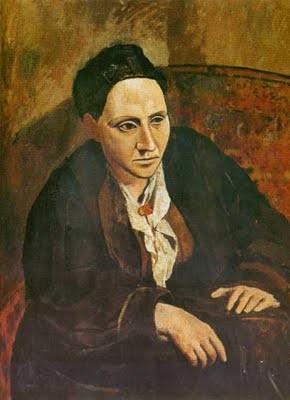Portraits & grammar
Gertrude Stein, a lesson play (part 2)

My last commentary on Gertrude Stein focused on “If I Told Him,” particularly in the context of thinking about how language has “the potential for change and to change.” I also really focused on a particular “lesson” or sequence of writing prompts that ask students to really engage with this text and write themselves into and out of Stein’s grammar. What I am most interested in is the way that Stein’s work really changes the way students approach writing and relate to their own writing. But, what is it about Stein? Why is it that Stein (semester after semester) proves to be an invitation for students to write? And, how does engaging with Stein demystify the moniker of “writer” for students?
In a 1935 interview with John Hyde Preston, Stein states,
you will write…if you will write without thinking of the result in terms of a result, but think of the writing in terms of discovery, which is to say that creation must take place between the pen and the paper, not before in a thought or afterwards in a recasting…It will come if it is there and if you will let it come.
What is striking about this passage, beyond the fact that it is a remarkable insight into Stein’s own creative process, is the way she pinpoints the notion of “writing to discover”—something that will become synonymous with freewriting (which arguably does not enter our pedagogical vocabulary until that late 1960’s with Ken Macrorie’s Writing to Be Read). And, Stein is also speaking before the publication of Williams’ 1936 essay, “How to Write,” in which he urges, “Forget all rules, forget all restrictions, as to taste, as to what ought to be said, write for the pleasure of it--whether slowly or fast--every form of resistance to a complete release should be abandoned…” Again, Williams seems to be describing the process that would later become dubbed “freewriting,” and again, his phrasing echoes Stein’s—“if you will let it come.”
***
I love to teach Stein’s “word portraits.” I begin by asking students to write about the word “portrait”—and we explore some of the common definitions of portraiture (i.e. visual, realistic, focus on a person from the shoulders up, etc.). We then write about what a “completed portrait” might be—delving into the implications of Stein’s title, “If I Told Him: A Completed Portrait of Picasso.” A “completed portrait” often reminds us of a finished painting, something housed in a museum, yet students are often baffled by Stein’s rendering of Picasso. They ask—where is “he” in this portrait? My response—what do we really need to make a portrait out of words? What is the goal of a portrait—for you, for Stein?
In “Portraits and Repetition,” Stein describes her turn to portraiture as “I was creating in my writing by simply looking” (113). For students, this statement underscores the value of detail and description in formal writing. But, it also provides students with an example of how one can trust what he or she sees/hears and then translate that into words, rather than rely on outside research and ideas that belong to others. Just as Stein draws a clear distinction between “entity” and “identity,” writing, “I created something out of something without adding anything” (121), students too need to realize that writing centers around one’s own ability (and willingness) to “[make it] contained within the thing I wrote that was them” (118). In other words, Stein’s portraits open the doors for students to understand what it means to look and record—from one’s own lens, painstakingly.
When teaching “If I Told Him,” a colleague of mine asked his class to write their own “completed portraits,” of the student in the room they each knew the least. I often ask my students to write their own self-portraits (or auto-portraits). They then exchange auto-portraits anonymously (if possible) and write a new “portrait” of what the reader thinks the writer learned from Stein. Is there a way to write a portrait of the learning process? Can we write to discover what it means to write to discover? Or, "do you do you do you really understand" (Stein 107).
Notes:
Preston, John Hyde. "A Conversation with Gertrude Stein." The Creative Process: A Symposium. Ed. Brewster Ghiselin. Berkeley: University of California, 1952. 164-72. Print.
Stein, Gertrude. Look at Me Now and Here I Am: Writings and Lectures, 1911-1945. London: Peter Owen, 2004. Print.
Williams, William Carlos. “How to write.” New Directions in Poetry and Prose, 1936. Ed. James Laughlin. New York: New Directions Books, 1986.
Pedagogy and poetry